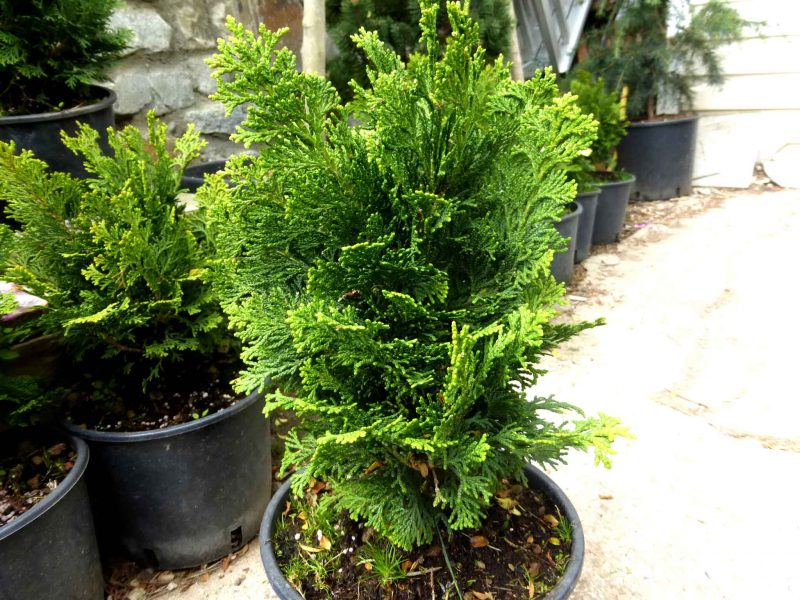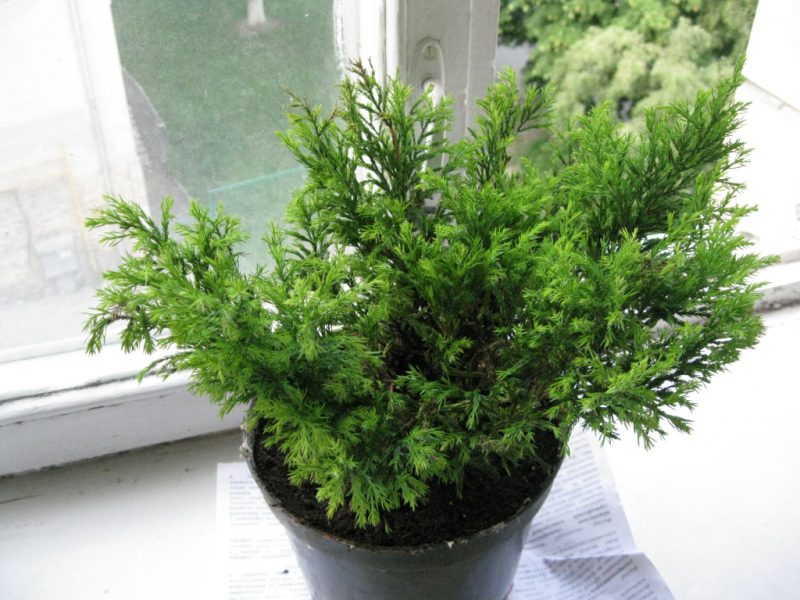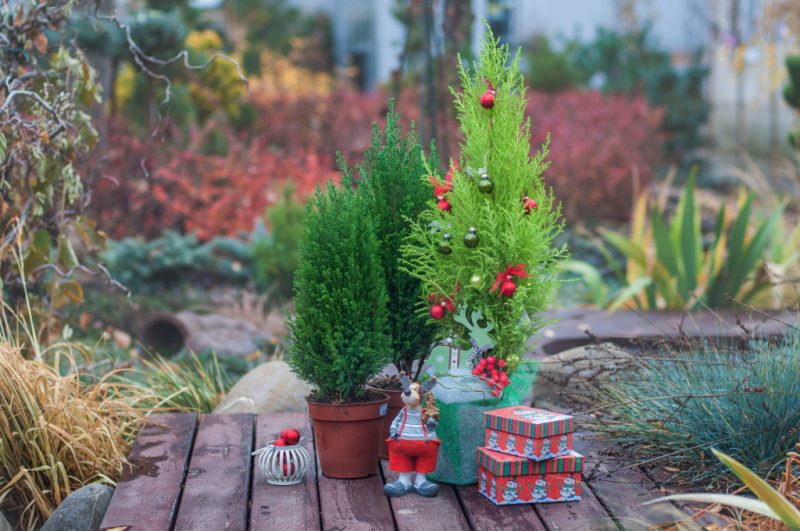Cypress is an evergreen coniferous plant with a pyramidal crown resembling thuja. Until recently, it was said that conifers were unsuitable for cultivation in a room medium, which was refuted over time. Today, it is no longer a curiosity to see representatives of cypress or pine on the windowsill.
Material Content:
Cypress: types and varieties
The genus is represented by 7 species, on the basis of which breeders were able to develop more than 100 forms and varieties for cultivation.

Among the most popular are:
- Lavson's cypress. View from North America, where individual specimens can reach a height of 70 m. Plants are distinguished by a narrow-conical crown of green color with the apex inclined to the side. The diameter of light brown cones does not exceed 10 cm. Of the popular varieties, the Elwoodi cypress tree stands out - a three-meter-tall plant with a blue crown, which became the basis for breeding many forms that differ in the color of the needles.
- The cypress is thuoid. A characteristic feature of the species is the smell of blue or light green needles, which it exudes when rubbed. Common varieties: Konika, Endelayensis.
- Cypress pea. The species, reaching a height of 30 m in the natural environment, arrived in Europe from the country of the Rising Sun. The tree is represented by a wide cone-shaped crown of a bluish-blue color.Yellow-brown cones with a diameter of up to 6 mm became the cause of the appearance of the name of the species "pea". Varieties that deserve attention: "Boulevard" with a pin-shaped crown, "Filifera" with drooping shoots and a short (up to 60 cm) variety "Nana".
Features of growing at home

When cultivating an apiary, do not forget about some of its features:
- love for a lot of soft light;
- moisture lovingness;
- the need to maintain a moderate temperature regime.
Planting and transplanting a cypress in a pot
A cypress in a pot grows as well as in open ground. For planting, which is best done in the spring, healthy seedlings are selected without injured shoots and diseased roots.

To become the owner of a room conifer, it is important to follow this algorithm:
- A robust container is selected, the dimensions of which depend on the size of the root system of the seedling.
- A drainage layer of broken brick is placed at the bottom.
- A seedling descends from above, which is covered with a soil mixture of turf land, humus, peat and sand in a ratio of 3: 3: 2: 1.
If the plant was already bought in a flowerpot, then transplantation into a fresh, nutrient substrate should be carried out at the end of a two-week quarantine. Culture is transplanted by transshipment.
Advice! To limit the growth of indoor cypress, it is necessary to carry out a light pruning of the roots during transplantation.
Caring for cypress at home
A coniferous plant in a room environment requires similar care, as in the case of its cultivation in open ground.
Optimal conditions for growing
Cypress, the green color of the crown of which is preserved throughout the year, stands out for the unique beauty inherent only to this plant.

But in order to become the owner of such a “miracle”, it is worth making efforts and creating the necessary conditions for keeping the cypress in the apartment environment:
- Lighting. A coniferous plant needs a lot of diffused light. To maintain the decorativeness of the crown of an indoor conifer, it is worth placing it near the south-facing windows with oppression in the summer. But in winter, the culture will be very grateful to the grower for such a choice, since the light coming from the southern windows will be quite enough for him.
- Temperature. For cypress, the optimum temperature values range between 14 - 20 ° C, where the latter value is acceptable only for the spring-summer period. Most species can tolerate frost and fever, but experience some stress from this.
How to water and spray?
When growing indoor cypress, it is worthwhile to install an irrigation system in which the possibility of the development of fungal diseases will be excluded.

Another abundant hydration is carried out after drying of the upper layer of earthen coma.
Young specimens need to be sprayed 2-3 times a week, depending on the air temperature in the room. During the procedure, settled water of room temperature is used.
Plant nutrition and fertilizer
Ephedra, regardless of where they are grown, need additional nutrition. Top dressing is carried out in the summer season with the help of liquid complex mineral fertilizers, which are applied only after the next portion of moisturizing.
The concentration of fertilizers for feeding cypress should be half that indicated on the package.
Crown shaping and trimming
In the natural environment, the cypress tree is characterized by branching and the ability to independently form the correct beautiful crown. In an apartment, when the light enters one-sidedly, it is worthwhile to trim to maintain the stability of the plant and its decorativeness, removing unnecessary branches that have broken out of the total mass. Also, a sanitary haircut is periodically carried out, in which damaged and dry shoots are removed.
Winter care
An evergreen does not have a pronounced state of dormancy, which the culture actually needs. With an increase in the duration of the dark time of the day, the feeding of the cypress tree ceases, the frequency and volume of watering are reduced, and spraying, which can provoke the development of fungal diseases, is completely eliminated.
How to deal with diseases and pests

Among the harmful organisms to which the cypress has developed quite good immunity, the following stand out:
- Scaffold and spider mite. Sucking pests that feed on the sap of the plant and cause yellowing and drying of the plant. To combat them, it is better to resort to chemical methods of protection using insecticides.
- Root rot. Fungal disease caused by excessive moisture in the culture. At the first sign, the affected specimen can be saved if it is removed from the substrate and the roots affected by rot are removed. After that, the remaining should be treated with fungicide. With intensive development, the specimen is subject to complete destruction.
Cypress propagation
A representative of cypress can reproduce both by seed and by vegetative methods.
Seed propagation method
At home, a laborious method that does not guarantee the preservation of varietal qualities is not applied.

The exception is the selection experiments of experienced gardeners, in which the sowing is carried out according to the following scheme:
- Seeds for stratification are placed in the refrigerator.
- With the advent of spring, seed is sown in a loose substrate.
- Tanks are transferred to a bright and warm place.
- With thickened seedlings, seedlings dive.
- Seating for individual tanks is carried out after the seedlings are well strengthened.
Cutting cypress
The most productive and popular technique, for the successful outcome of which:
- In spring, cuttings are cut from young apical shoots, the length of which is from 5 to 15 cm.
- Slice sites are treated with a growth stimulator.
- Cuttings are buried in a substrate of sand and perlite in equal shares and covered with banks.
- For several months, banks are periodically removed to moisten the plantings.
- After 2 months, rooting is noted, after which additional protection is removed, and young plants are planted in individual pots.
Propagation by layering

The method is acceptable only for creeping forms and represents the following algorithm:
- The shoot with the previously damaged bark bends to the ground, where it is fixed and sprinkled with a substrate.
- For several months, the rooting layer is taken care of, like an adult plant, watering and feeding it.
- After rooting, the cuttings are separated from the parent plant and transplanted into a separate pot.
So, if the florist has a desire to become the owner of an apiary in a pot, he only needs to get acquainted with some of the nuances of its content, after which you can safely get down to business.












